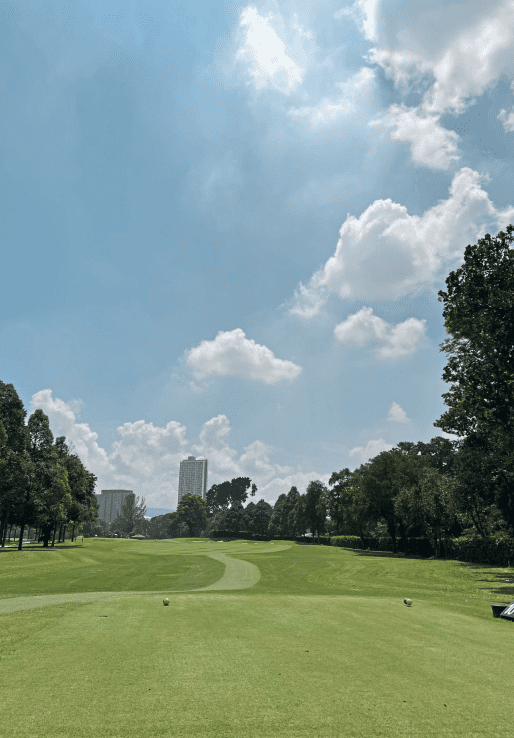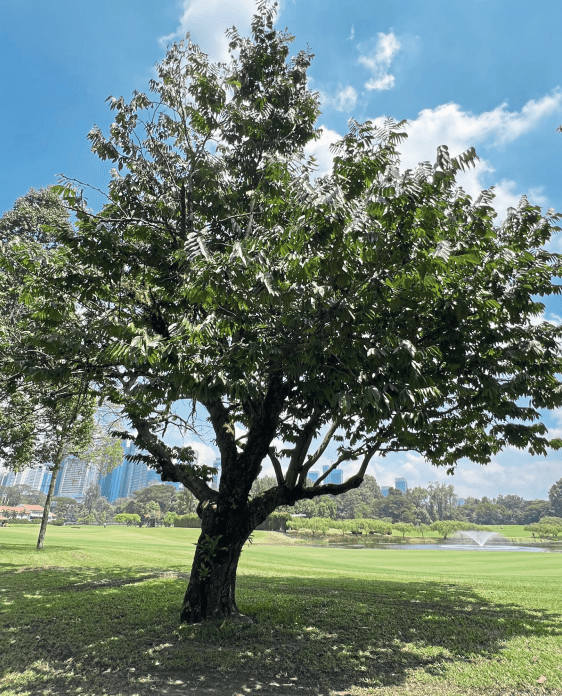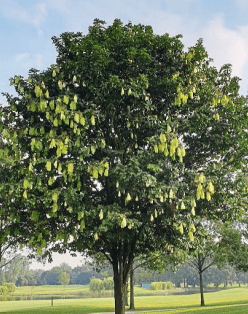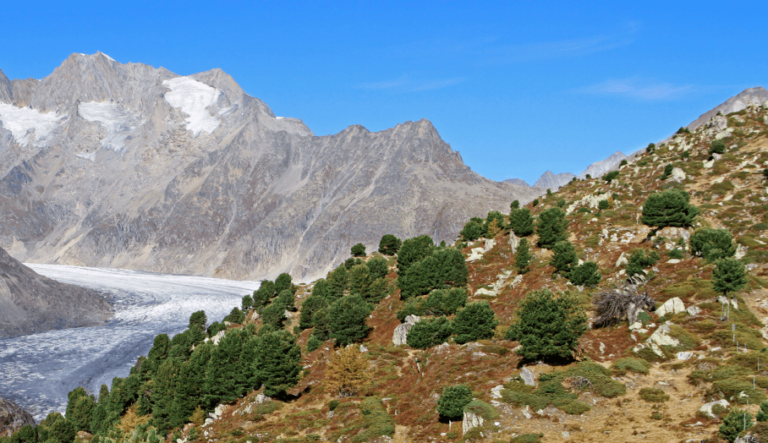Join us for an immersive nature walk on 21 May 2024, starting at the scenic 10th Hole New Course as the first tee-off point for the course. As golfers tee off, take in the view of the lush greenery and towering trees in the morning sun. Our walk will unveil seven remarkable tree species, each offering unique insights and experiences at designated stations along the trail.
Station 1 – Saraca cauliflora
STATION 1 – SARACA CAULIFLORA – GAPIS
Gapis is a medium-sized evergreen tree of up to 20m tall. It has a wide-spreading crown. It is attractive for its large clusters of yellow flowers and young coloured leaves which hang in tassels. It originates from Malaysia and West Java. It is quite shade-tolerant and can be planted as an understorey tree. The bark is smooth, leaves are big compounds with large leaflets. The young leaves hang down for several days in pinkish to purplish tassels, then turn a light greenish-white before becoming green and turning to normal within a short time.
The flowers arise from the trunk and main branches. The petal-less flowers are small, light yellow and turn deep yellow. The trees generally flower twice a year after pronounced dry weather. The fruit is a large flattened pod which is striking purple and split open when ripe.
Station 2 – Maniltoa browneoides
STATION 2 – MANILTOA BROWNEOIDES – HANDKERCHIEF TREE
A medium-sized evergreen tree that has a large rounded crown and is evenly spaced. It is planted for aesthetic purposes for its attractive young new leaves along the roadside, golf courses, parks and 10th Hole New Course gardens. These very prominent young flushes of light green new leaves resemble soft white handkerchiefs, hanging vertically downwards from the branches, hence its common name. These dropping young leaves stand out distinctively against the darker foliage and turn green, harden and become erect within a few days.
It produces bunches of white flowers with papery brown bracts which grow from the end of branches. The flowers appear to attract birds such as starlings and sunbirds. The fruit is a broad woody pod which contains a single seed which can be easily propagated. The wood of the Handkerchief tree is fairly strong and durable and is used in construction, furniture and charcoal.
STATION 3 – DRYOBALANOPS AROMATIC – KAPUR
Dryobalanops aromatic locally known as Kapur is known to grow up to 45 m in its natural habitat (mixed dipterocarp forests). It has buttress roots and resin which is known as dammar. The specific epithet ‘aromatica’ is derived from Latin (aromaticus) which refers to the smell of the dammar (resin). All parts of the tree produce a camphor-like fragrance.
The leaves are ovate, acuminate, coriaceous with alternate arrangement, measuring about 4-6cm long. The flowers are white and are borne on axillary and terminal panicle inflorescence up to 7cm long.
Back in the day, this tree was one of the camphor sources that attracted Arab traders to Borneo. This tree is also the most important source of high-quality timber, known as Kapur, which is used locally and also treated.
STATION 4 – HOPEA ODORATA –MERAWAN
Hopea odorata locally known as Merawan Siput Jantan is a large tree with a conical shaped crown when young and oval once matured. This species can reach up to 40m in height and diameter up to 4.5m. The trunk also has short buttresses. In its natural habitat, this species is found near streams and rivers.
The leaves are alternate, oblong to ovate-lanceolate with an entire leaf margin measuring about 7-14cm in length by 3-7cm in width. The flowers are small, fragrant, and yellowish-white and located at the leaf axils or branch tips. The fruits are small, brown and winged. It has two long and three short wings. The fruit which contains one seed will be dispersed by wind.
The timber from Hopea odorata is classified as medium-heavy hardwood and is usually used to build houses, boats and canoes. This species is suitable for roadside planting due to its fast growth and straight upright form. It is also resistant to fungal and termite attacks
STATION 5 – SYZYGIUM POLYANTHUM – SALAM
Syzygium polyanthum or Salam is a medium to tall tree growing between 20-30 m high. The crown is open, oval or cylindrical in shape.
It is native to Malaysia, Burma, Indochina, Philippines. The tree is deciduous and sheds its leaves before flowering. The trunk is grey with a flaky bark when mature. The bark is used for tanning, fishing nets and for colouring mats. Extract of the bark is also used traditionally. The wood is pale brown to pinkish yellow with a purplish tinge. A medium-weight to heavy hardwood, it is used for house building and furniture.
The leaves, light green in colour, are simple, elliptical and narrow towards the ends. The leaves when crushed give a distinct ‘jambu’ smell and are commonly used in cooking to impart aroma to the food. The flowers are creamy white in small clusters. The fruit is a single-seeded berry dark red to purplish–black when ripe. The ripe fruits are edible and attract birds.
Salam is fast growing and suitable to be planted as an urban tree in gardens and roadside planting.
STATION 6 – DILLENIA INDICA – ELEPHANT APPLE
Dillenia indica is a medium-sized tree growing up to 25cm tall. The trunk has a flaky bark and is reddish brown. The leaves are about 15-30cm long, alternate with serrated margins and many parallel secondary veins. The flowers are big in size, about 15-20cm wide, with yellowish-green sepals and white petals, opening at night and fading by noon. The flowers are at the end of the branches facing down. The flowers are pollinated by bats and bees.
The fruits are round, 10-15 cm in diameter and covered by thick sepals, turning from green to yellowish-green once ripen and do not split open. The unripe fruits are also cooked and pickled. This species can be easily propagated by seeds. Suitable to be planted in parks but not in parking lots because of the size of the fruits which could be hazardous.
STATION 7 – CALOPHYLLUM INOPHYLLUM – PENAGA LAUT
Callophyllum inophyllum is a medium-sized tree with a spreading crown. This species grows up to 20 m tall. It is found from East Africa, Madagascar, Indian Ocean Islands, Sri Lanka, India, Southeast Asia, Taiwan and Southeast China to North Australia, New Caledonia and the Pacific Islands. This is a hardy species and prefers full sun. This species has an irregular crown. The trunk is usually short, twisted or leaning. The bark is dark and fissured. It exudes latex when injured
The leaves are simple, 8-18 cm long, opposite, oval to oblong, leathery and glossy. The leaf stalk is short and thick. The flowers are white, fragrant and in erect bunches, 2-2.5cm long. The fruits are round, bear only one seed and are green to brownish when ripe.
The wood is used to make boats, furniture and musical instruments. The timber has a fine grain and is fairly durable. This species is also widely planted as an ornamental street tree.
Join us on this captivating nature walk – A Journey to learn about trees of the 10th Hole New Course on 21 May 2024. Engage your senses as we explore these magnificent trees, from observing their leaves and flowers to experiencing their unique fragrances in this nature walk.
For further enquiries or information, please do not hesitate to contact your horticulturist at nur.farizaa@ rsgc.com.my
The Calophyllum inophyllum canopies







